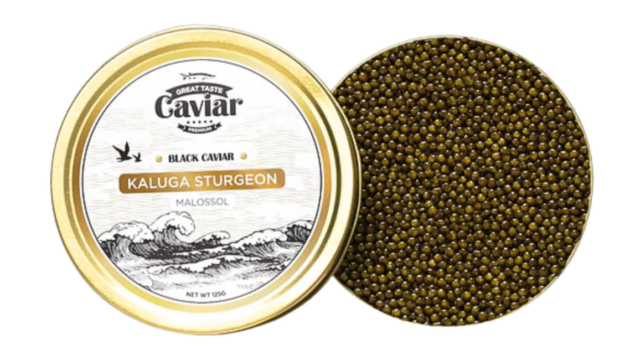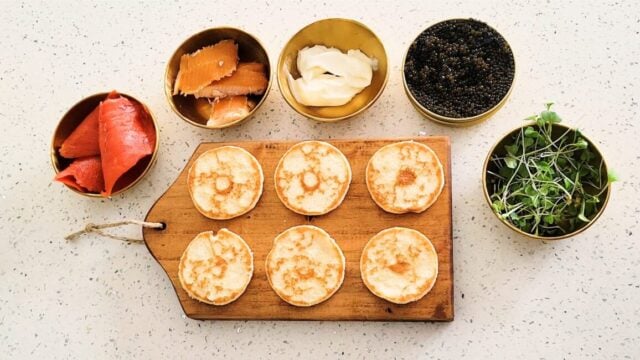This post may contain affiliate links. Please read our
disclosure policy
for more information.
Recently, I opted for a new kind of caviar I hadn’t tried before: the Kaluga Fusion Sturgeon from Great Taste.
As someone who’s been around food in a professional sense for decades, I’ve tried a lot of caviar! I love caviar, though I do consider a special occasion type of treat. And I’ve had my share of great caviar and not-so-great caviar. This Kaluga Sturgeon is some very high quality caviar!
While I was excited to try it, I realized I had some questions about how to best store it. Of course, I wanted to make sure I got to enjoy it at peak quality. And I figured I couldn’t be the only one with questions about how long caviar lasts (both before and after opening it). And as it turns out, it’s a common caviar commundrum!

So today we’re diving into my thoughts on Great Taste’s black caviar, as well as how to keep this very perishable product the freshest it can be!
About Great Taste’s Kaluga Sturgeon Black Caviar

Great Taste’s Kaluga Sturgeon is like the crème de la crème of the fish roe world.
Each bead of this black caviar comes with a noble golden shimmer, as if each little roe is dressed up in its Sunday best, just waiting to dazzle your taste buds. And not only does this Kaluga sturgeon delight have an amazing taste, but it’s also like a superhero for your health! We’re talking a powerhouse of essential nutrients, from calcium and magnesium to zinc and unsaturated fatty acids, all joining forces to give your body a general tonic boost.
Some of My Favorite Things About this Caviar

The Pros of this Incredible Caviar
The Texture: Imagine the most delicate, almost whisper-thin fabric. That’s how tender this caviar feels as it melts in your mouth. You can tell it’s high quality from the texture alone.
The Taste: There’s an interesting mix of lightly nutty and creamy notes, that are simultaneously bold and comforting. I really love it!
The Pairing: I paired this with some salmon, creme fraiche, and microgreens on a blini, and LOVED the combo. The caviar truly enhanced the flavors of the other ingredients but was also so distinct in its own way without overpowering any other flavors.
The Cons:
If I had to nitpick, the only downside (if you could even call it that) would be the comedy of errors that ensued when I tried to open the container. I couldn’t tell if it was a twist-top or a pop-top, and I tried EVERYTHING to open it. A silicone jar holder for traction. A bottle opener. Sheer brute force. It wasn’t budging. Eventually, I had to employ the help of my husband, who also went through a series of hilarious attempts until he finally just grabbed a small flathead screwdriver, stuck the edge between the lid and bottom tin and turned the edge to a vertical position (like you would a key) to separate them, and viola! Fresh caviar!
We ended up laughing about how easy it was to open after all that struggle. (So, heads up if you find yourself in the same predicament! Flat head like this: — under the lip of the lid, and then twist to this position: | to pop the lid up!)
Now let’s get into how you would best store caviar to get the most out of the shelf life of this delicacy!
How Long Does Caviar Last?

So, how long does caviar last? If you’re fishin’ for a quick answer, here it is: unopened caviar can last in your fridge for up to 4-6 weeks, thanks to its pristine vacuum-sealed container. But once that seal is broken, that timeline drops dramatically, and you’ve only got about 2 to 3 days to enjoy it. Of course, it’s not always that cut and dry. There are many factors to keeping caviar fresh, so let’s talk about them.
Factors that Affect the Shelf Life of Caviar
Here are some factors that can affect the shelf life of your caviar:
- Storage Temperature: Caviar should be kept at an ideal storage temperature between 28 and 32 degrees Fahrenheit. Your best bet to achieve this is to keep it in the coldest part of your refrigerator. The lower and further back in your fridge, the better. Never leave your caviar at room temperature for longer than 2 hours. Keeping caviar at too warm temps is an invite for microbes to come and spoil your party.
- Air Exposure: Caviar’s worst enemy is air, and it can lead to faster spoilage. Keep your caviar in its vacuum-sealed, airtight container and don’t open it until just before you’re about to enjoy it.
- Salt Content & Pasteurization: Malossol caviar means it contains little salt. This helps to preserve caviar but also means it won’t last as long as heavily salted roe. When properly pasteurized, some sealed caviar can last up to 6 months in the fridge. Pasteurization, however, exposes roe to high heat to kill off contaminants, which can also make it rubbery and compromise its delicate texture. This is why most caviar-lovers enjoy the unpasteurized variety.
- Type of Caviar: From beluga caviar to salmon roe, each has its own diva demands in order to achieve optimal shelf life, and high-quality caviar tends to be more perishable.
- Handling: The less you handle caviar, the better. Use clean utensils to avoid contaminating your precious pearls with food particles.
How to Tell When Your Caviar Has Gone Bad
Even the most luxurious delicacies have their expiration, and caviar is no exception. Here’s how you can tell if it’s time to bid adieu to your caviar:
- Off Odor: Fresh caviar should smell like the ocean, briny and fresh. If it smells fishy or off, trust your nose, take a note from Frozen, and let it gooooooo.
- Color Changes: Caviar comes in an array of colors, and it should maintain that color. If it turns dull or changes color, that’s a sure sign of spoilage.
- Texture: Caviar should have a delicate texture, with each roe intact and firm. If the eggs become mushy or overly soft, throw it out.
- Mold: Yes, even caviar can mold. Any visible signs of mold means the caviar has gone bad.
As always, when it doubt, throw it out!
Can You Freeze Caviar For Longer Storage?
To freeze or not to freeze your caviar? While freezing caviar can extend its expiration date into well over a year, not all caviar types play well with the cold. Freezing tends to compromise the quality of the caviar, especially premium sturgeon caviar.
If you consider yourself any kind of caviar connessoir, you’re probably looking to enjoy it at optimal quality and get the best flavor out of it, and if that’s the case, freezing your caviar is a huge no-no. (The exception to this includes firmer roes like Tobiko (flying fish) or Masago (capelin), because the eggs are hardier, with a texture that can withstand the freezing process without losing quality.)
So while you can freeze caviar, you probably shouldn’t. A better option is simply to keep your unopened container of caviar at the coldest part of your fridge.
Caviar FAQs

What is the best way to store unopened caviar?
The best way to store unopened caviar is in the coldest part of the fridge, ideally at the back of the bottom shelf or drawer. Make sure to keep the jar or tin unopened until you’re ready to indulge.
Can I use metal spoons with my caviar?
Metal spoons, especially when made of silver or stainless steel, can react with the delicate flavor of caviar, and make it taste metallic. Instead, opt for mother of pearl, bone, glass, or plastic spoons to preserve the flavor.
My caviar came in a metal container. Can’t that compromise the taste?
While some caviar does come in a tin container, manufacturers make sure they’re lined with a non-reactive material lining, so the caviar doesn’t actually touch the metal.
How long does caviar last once opened?
Once opened, you should enjoy your caviar within 2-3 days.
Can I freeze caviar?
While freezing caviar can extend its shelf life, it’s generally not recommended, especially if it’s of the sturgeon variety. Freezing can compromise your caviar’s delicate taste and texture. However, firmer roes like Tobiko or Masago can be frozen without significant quality loss.
What garnishes pair well with caviar?
Garnishes that complement the flavor of caviar without overpowering it include lemon wedges, sour cream, hard-boiled eggs, and blinis.
How can I tell if my caviar has gone bad?
Signs of spoilage in caviar include a bad odor, change in color, and a mushy texture. If the caviar tastes sour or unpleasant, discard it.
Are there different types of caviar?
Yes, there are LOTS of caviar types, including black caviar from sturgeon species like Beluga, Osetra, and Sevruga, and red caviar, primarily from salmon. Each type offers its own unique flavor. The ideal storage temperature can vary slightly between these types.
The Final Word

Check Out Our Tutorial on How To Make a Blini Spread Using Great Taste’s Caviar!
We hope you enjoyed this review and that we were also able to demystify the shelf life of caviar for you. Don’t forget that the way you store it can mean the difference between “mmm” and “meh” when it comes to your roe. So keep it cool, keep it sealed, and most importantly, keep enjoying those little pearls of joy.
Got any caviar stories or tips of your own? Don’t be shy, drop them in the comments below! We’d love to hear about them!
This post may contain affiliate links. Please read our
disclosure policy
for more information.
This post may contain affiliate links. Please read our
disclosure policy
for more information.
Recently, I opted for a new kind of caviar I hadn’t tried before: the Kaluga Fusion Sturgeon from Great Taste.
As someone who’s been around food in a professional sense for decades, I’ve tried a lot of caviar! I love caviar, though I do consider a special occasion type of treat. And I’ve had my share of great caviar and not-so-great caviar. This Kaluga Sturgeon is some very high quality caviar!
While I was excited to try it, I realized I had some questions about how to best store it. Of course, I wanted to make sure I got to enjoy it at peak quality. And I figured I couldn’t be the only one with questions about how long caviar lasts (both before and after opening it). And as it turns out, it’s a common caviar commundrum!

So today we’re diving into my thoughts on Great Taste’s black caviar, as well as how to keep this very perishable product the freshest it can be!
About Great Taste’s Kaluga Sturgeon Black Caviar

Great Taste’s Kaluga Sturgeon is like the crème de la crème of the fish roe world.
Each bead of this black caviar comes with a noble golden shimmer, as if each little roe is dressed up in its Sunday best, just waiting to dazzle your taste buds. And not only does this Kaluga sturgeon delight have an amazing taste, but it’s also like a superhero for your health! We’re talking a powerhouse of essential nutrients, from calcium and magnesium to zinc and unsaturated fatty acids, all joining forces to give your body a general tonic boost.
Some of My Favorite Things About this Caviar

The Pros of this Incredible Caviar
The Texture: Imagine the most delicate, almost whisper-thin fabric. That’s how tender this caviar feels as it melts in your mouth. You can tell it’s high quality from the texture alone.
The Taste: There’s an interesting mix of lightly nutty and creamy notes, that are simultaneously bold and comforting. I really love it!
The Pairing: I paired this with some salmon, creme fraiche, and microgreens on a blini, and LOVED the combo. The caviar truly enhanced the flavors of the other ingredients but was also so distinct in its own way without overpowering any other flavors.
The Cons:
If I had to nitpick, the only downside (if you could even call it that) would be the comedy of errors that ensued when I tried to open the container. I couldn’t tell if it was a twist-top or a pop-top, and I tried EVERYTHING to open it. A silicone jar holder for traction. A bottle opener. Sheer brute force. It wasn’t budging. Eventually, I had to employ the help of my husband, who also went through a series of hilarious attempts until he finally just grabbed a small flathead screwdriver, stuck the edge between the lid and bottom tin and turned the edge to a vertical position (like you would a key) to separate them, and viola! Fresh caviar!
We ended up laughing about how easy it was to open after all that struggle. (So, heads up if you find yourself in the same predicament! Flat head like this: — under the lip of the lid, and then twist to this position: | to pop the lid up!)
Now let’s get into how you would best store caviar to get the most out of the shelf life of this delicacy!
How Long Does Caviar Last?

So, how long does caviar last? If you’re fishin’ for a quick answer, here it is: unopened caviar can last in your fridge for up to 4-6 weeks, thanks to its pristine vacuum-sealed container. But once that seal is broken, that timeline drops dramatically, and you’ve only got about 2 to 3 days to enjoy it. Of course, it’s not always that cut and dry. There are many factors to keeping caviar fresh, so let’s talk about them.
Factors that Affect the Shelf Life of Caviar
Here are some factors that can affect the shelf life of your caviar:
- Storage Temperature: Caviar should be kept at an ideal storage temperature between 28 and 32 degrees Fahrenheit. Your best bet to achieve this is to keep it in the coldest part of your refrigerator. The lower and further back in your fridge, the better. Never leave your caviar at room temperature for longer than 2 hours. Keeping caviar at too warm temps is an invite for microbes to come and spoil your party.
- Air Exposure: Caviar’s worst enemy is air, and it can lead to faster spoilage. Keep your caviar in its vacuum-sealed, airtight container and don’t open it until just before you’re about to enjoy it.
- Salt Content & Pasteurization: Malossol caviar means it contains little salt. This helps to preserve caviar but also means it won’t last as long as heavily salted roe. When properly pasteurized, some sealed caviar can last up to 6 months in the fridge. Pasteurization, however, exposes roe to high heat to kill off contaminants, which can also make it rubbery and compromise its delicate texture. This is why most caviar-lovers enjoy the unpasteurized variety.
- Type of Caviar: From beluga caviar to salmon roe, each has its own diva demands in order to achieve optimal shelf life, and high-quality caviar tends to be more perishable.
- Handling: The less you handle caviar, the better. Use clean utensils to avoid contaminating your precious pearls with food particles.
How to Tell When Your Caviar Has Gone Bad
Even the most luxurious delicacies have their expiration, and caviar is no exception. Here’s how you can tell if it’s time to bid adieu to your caviar:
- Off Odor: Fresh caviar should smell like the ocean, briny and fresh. If it smells fishy or off, trust your nose, take a note from Frozen, and let it gooooooo.
- Color Changes: Caviar comes in an array of colors, and it should maintain that color. If it turns dull or changes color, that’s a sure sign of spoilage.
- Texture: Caviar should have a delicate texture, with each roe intact and firm. If the eggs become mushy or overly soft, throw it out.
- Mold: Yes, even caviar can mold. Any visible signs of mold means the caviar has gone bad.
As always, when it doubt, throw it out!
Can You Freeze Caviar For Longer Storage?
To freeze or not to freeze your caviar? While freezing caviar can extend its expiration date into well over a year, not all caviar types play well with the cold. Freezing tends to compromise the quality of the caviar, especially premium sturgeon caviar.
If you consider yourself any kind of caviar connessoir, you’re probably looking to enjoy it at optimal quality and get the best flavor out of it, and if that’s the case, freezing your caviar is a huge no-no. (The exception to this includes firmer roes like Tobiko (flying fish) or Masago (capelin), because the eggs are hardier, with a texture that can withstand the freezing process without losing quality.)
So while you can freeze caviar, you probably shouldn’t. A better option is simply to keep your unopened container of caviar at the coldest part of your fridge.
Caviar FAQs

What is the best way to store unopened caviar?
The best way to store unopened caviar is in the coldest part of the fridge, ideally at the back of the bottom shelf or drawer. Make sure to keep the jar or tin unopened until you’re ready to indulge.
Can I use metal spoons with my caviar?
Metal spoons, especially when made of silver or stainless steel, can react with the delicate flavor of caviar, and make it taste metallic. Instead, opt for mother of pearl, bone, glass, or plastic spoons to preserve the flavor.
My caviar came in a metal container. Can’t that compromise the taste?
While some caviar does come in a tin container, manufacturers make sure they’re lined with a non-reactive material lining, so the caviar doesn’t actually touch the metal.
How long does caviar last once opened?
Once opened, you should enjoy your caviar within 2-3 days.
Can I freeze caviar?
While freezing caviar can extend its shelf life, it’s generally not recommended, especially if it’s of the sturgeon variety. Freezing can compromise your caviar’s delicate taste and texture. However, firmer roes like Tobiko or Masago can be frozen without significant quality loss.
What garnishes pair well with caviar?
Garnishes that complement the flavor of caviar without overpowering it include lemon wedges, sour cream, hard-boiled eggs, and blinis.
How can I tell if my caviar has gone bad?
Signs of spoilage in caviar include a bad odor, change in color, and a mushy texture. If the caviar tastes sour or unpleasant, discard it.
Are there different types of caviar?
Yes, there are LOTS of caviar types, including black caviar from sturgeon species like Beluga, Osetra, and Sevruga, and red caviar, primarily from salmon. Each type offers its own unique flavor. The ideal storage temperature can vary slightly between these types.
The Final Word

Check Out Our Tutorial on How To Make a Blini Spread Using Great Taste’s Caviar!
We hope you enjoyed this review and that we were also able to demystify the shelf life of caviar for you. Don’t forget that the way you store it can mean the difference between “mmm” and “meh” when it comes to your roe. So keep it cool, keep it sealed, and most importantly, keep enjoying those little pearls of joy.
Got any caviar stories or tips of your own? Don’t be shy, drop them in the comments below! We’d love to hear about them!
This post may contain affiliate links. Please read our
disclosure policy
for more information.










